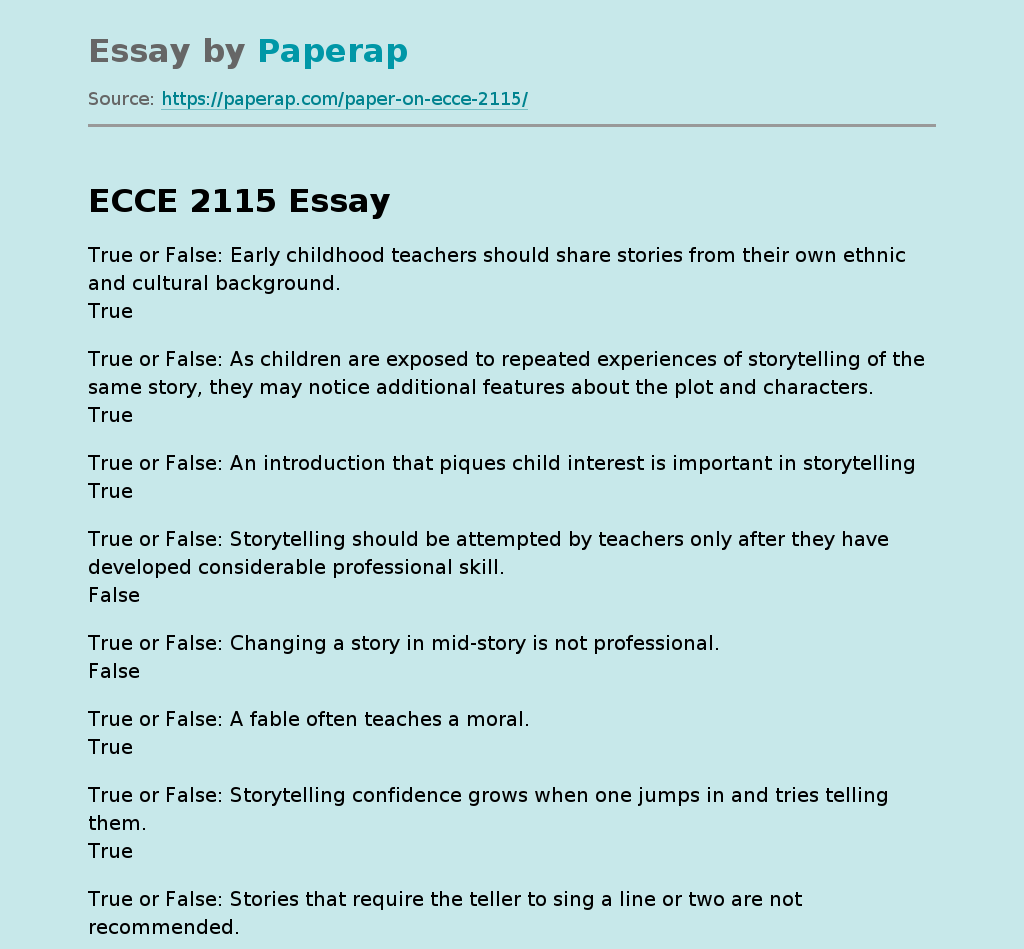Sharing Cultural Stories: True or False?
Essay,
Pages 4 (797 words)
Views
41
True or False: Early childhood teachers should share stories from their own ethnic and cultural background.
True
True or False: As children are exposed to repeated experiences of storytelling of the same story, they may notice additional features about the plot and characters.
True
True or False: An introduction that piques child interest is important in storytelling
True
True or False: Storytelling should be attempted by teachers only after they have developed considerable professional skill.
False
True or False: Changing a story in mid-story is not professional.
False
True or False: A fable often teaches a moral.
True
True or False: Storytelling confidence grows when one jumps in and tries telling them.
True
True or False: Stories that require the teller to sing a line or two are not recommended.
False
True or False: A good place to start storytelling to a group of preschoolers is to start telling little personal stories.
True
True or False: Children develop mental images during teacher storytelling as the story unfolds.
True
True or False: Circle times promote children’s group communication skills.
True
True or False: While leading circle times, teachers are primarily providers of knowledge.
False
True or False: Recognizing each child by name at circle time is unnecessary.
False
True or False: Language arts activities during circle times are repeated frequently.
True
True or False: Sitting for an extended period at circle time causes wiggling.
True
True or False: A teacher starts circle times by trying to gain children’s attention.
True
True or False: A circle-time teacher is busy leading rather than observing.
False
True or False: Some rhyming nursery songs emphasize alliteration.
True
True or False: Some poetry motivates child physical movement.
True
True or False: Poetry has little relationship to phonological awareness.
False
True or False: “Diddle, diddle, dumpling” demonstrates both repetition of consonant sounds and alliteration.
True
True or False: Poetry can contain rhythm, rhyme and repetition..
True
True or False: Most young children are inattentive when a puppet introduces an activity.
False
True or False: Cloth puppet faces are not recommended.
False
True or False: Drama is too mature for preschoolers.
False
True or False: Drama can include acting out strong emotions.
True
True or False: Audience skills include knowing when to clap.
True
True or False: Puppets can act out a story with teacher’s help.
True
True or False: Singing the “Alphabet Song” is often a child’s first experience with alphabet letters.
True
True or False: Uppercase letters may be easier to learn than lowercase letters.
True
True or False: A print awareness skill involves learning that words are read from the top to the bottom of a page.
True
True or False: Alphabet books are not developmentally appropriate for preschoolers
False
True or False: Children may learn alphabet letter names first and then their shapes.
True
True or False: It is commonplace for four-year-olds to read a few words.
True
True or False: Children’s names are printed on children’s work in the upper right-hand corner.
False
True or Fale: Preschoolers should observe their teachers’ printing letters.
True
True or False: Print awareness in now believed to begin at an early age.
True
True or False: Making a printed sign with a child is a print awareness activity.
True
True or False: Preschoolers’ knowledge of alphabet letters is a good predictor of early reading achievement.
True
True or False: Helping preschoolers who significantly lag behind their peers in language skills is unimportant before they reach kindergarten age.
False
True or False: Preschoolers have been known to memorize a picture book word for word.
True
True or Fale: Shared reading takes place when one child reads a book on the computer.
False
True or False: Phonetic reading instruction is superior to other methods according to recent research.
False
True or False: The National Reading Panel recommends that instruction in early literacy should be random and individualized.
False
True or False: A number of parents want reading skills taught during preschool years.
True
True or False: One technique useful for storytelling is being a the child’s level.
True (also, maintaining eye contac and using a prop)
Most good stories end with:
a. rising action and suspense
b. children mesmerized
c. a quick satisfying conclusion
a. rising action and suspense
b. children mesmerized
c. a quick satisfying conclusion
c. a quick satisfying conclusion
List in proper order the classic story pattern form.
1. introduction of setting and characters
2. problem introduction
3. rising action
4. insightful idea, answer, solution
5. climactic scene
6. quick, satisfying conclusion
2. problem introduction
3. rising action
4. insightful idea, answer, solution
5. climactic scene
6. quick, satisfying conclusion
True or false: The main goal in introducing children to poetry is promiting pleasure and enjoyment with this language art.
True
True or False: Poetry can amuse and entertain or become boring.
True
Characteristics that make poetry appealing to preschoolers.
simple story line, repeated elements, predictability, ease in learning, nonsense, participation opportunities, rhythm, cadence, funny characters, fun, wit, and wisdom.
Sharing Cultural Stories: True or False?. (2018, Jan 10). Retrieved from https://paperap.com/paper-on-ecce-2115/

